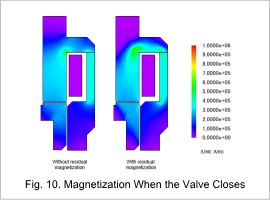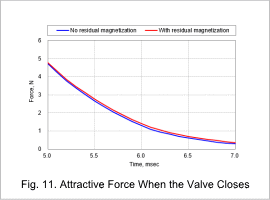Overview
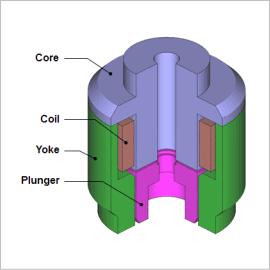
In this example. we will discuss the steps to investigate the effect on responsiveness caused by residual magnetization generated in the magnetic materials, and look at case examples.
Responsiveness
Fig. 1 shows a complete response graph comparing residual magnetization being accounted for and not accounted for, fig. 2 shows responsiveness when the valve opens, and fig. 3 shows responsiveness when the valve closes.
Fig. 1 demonstrates that responsiveness for the valve opening and closing differs depending if residual magnetization is accounted for or not. Fig. 2 and 3 demonstrates that responsiveness is lowered when residual magnetization is accounted for.
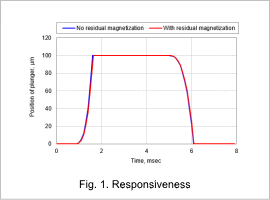
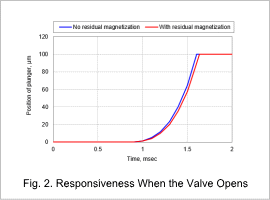
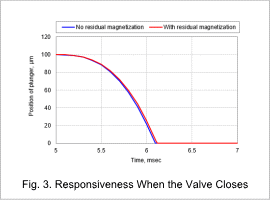
Responsiveness When Valve Opens
The cause behind a slower responsiveness when accounting for residual magnetization will be examined. Attraction force in the Y-axis direction when the valve opens is shown in Fig 4, and current values are shown in Fig. 5. We can verify that attractive force decreases in the Y-axis direction, and current values increase.
The cause behind a decrease in attractive force in this case is due to the difference in the how magnetic flux flows. Magnetic flux during the valve opening is shown in Fig. 6. It becomes clear that magnetic flux decreases when residual magnetization is accounted when compared to when it isn’t accounted for. The root cause is not due to the effect of residual magnetization, but due to the handling of the magnetization properties when the valve opens.
Magnetization properties used when the valve opens are shown in Fig. 7. During an analysis, an initial magnetization curve is used when residual magnetization is accounted for, and an average magnetization curve is used when residual magnetization is not accounted for, and then analysis is performed. In cases when average magnetization curves (not accounting for residual magnetization) are used, magnetic flux is generated easily when current flows, as shown in Fig. 7. As a result, attractive force in the Y-axis direction increases, and valve responsiveness improves compared to the initial magnetization curve (accounting for residual magnetization).
Furthermore, when residual magnetization is not accounted for, attractive force becomes larger than when residual magnetization is accounted for, but current values become smaller. For this case study, as shown in Fig. 8, using an average magnetization curve (not accounting for residual magnetization) results in a larger back electromotive force due to a lot of magnetic flux flow. Because of this, as shown in Fig. 9, as looking at the amount of magnetic flux generated per Ampere when the valve opens, the case where residual magnetization is not accounted for generates greater amount of magnetic flux per Ampere. Therefore, attractive force increases even if current values are small.
The cause for a decrease in responsiveness when the valve opens, as shown above, is not due to the effects of residual magnetization, but due to the differences in handling magnetization properties.
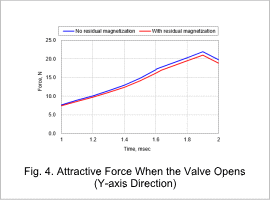
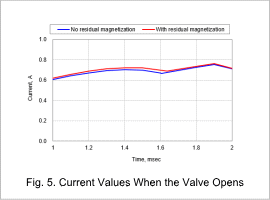
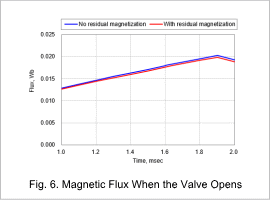
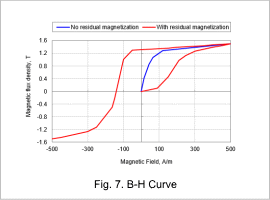
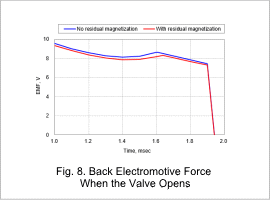
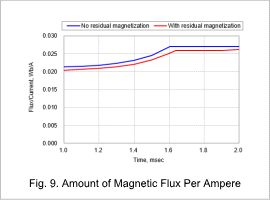
Responsiveness When Valve Closes
Magnetization contour plot when the valve closes at 0.005s is shown in Fig. 10. It shows that the yolk is magnetized while valve closes if residual magnetization is accounted for. Fig. 11 indicates that attractive force is maintained due to residual magnetization of yolk. This applied attractive force inhibits valve movement, and responsiveness decreases.
